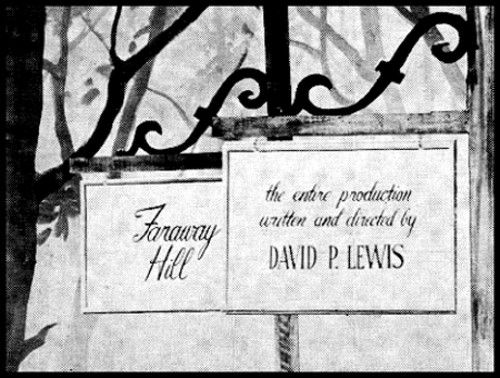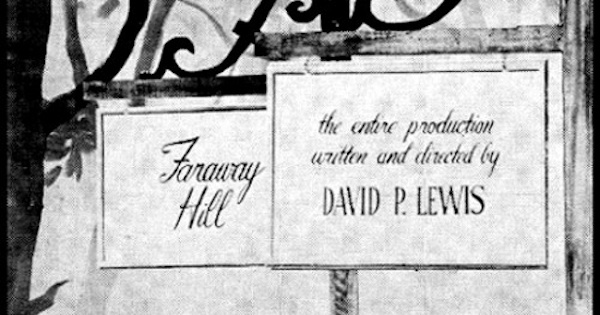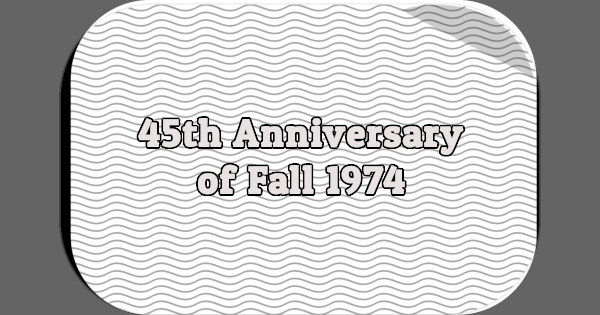Faraway Hill, generally considered the first prime time soap opera on network television in the United States, celebrates its 75thanniversary today. I’m reprinting a post I originally wrote back in 2016 commemorating the show’s 70th anniversary.
Faraway Hill premiered on DuMont on Wednesday, October 2nd, 1946 at 9PM. DuMont’s network at the time consisted of just two stations: WABD-TV in New York City and W3XWT (later WTTG) in Washington, DC. The series lasted for 12 weeks.
Truly Forgotten TV
Sadly, almost nothing is known about Faraway Hill. Flora Campbell starred as Karen St. John. Recently widowed, she decides to move from New York City to the country to visit relatives. She falls in love a man (played by Mel Brandt) who was engaged to another woman. That’s pure soap opera melodrama, right? The name of Brandt’s character is unknown. In fact, no other character names are known.
Others in the cast include Ann Stell, Julie Christy, Eve McVeagh, Vivian King, Ben Low, Jack Halloran, Frederic Meyer, and Jacqueline Waite.

The Caples Advertising Agency produced Faraway Hill. It had no sponsors. David P. Lewis served as writer and director. According to his 1992 obituary in the Los Angeles Times, Lewis based the series on an incomplete novel he wrote. Wikipedia claims the Lewis family owns the original scripts from the series.
Contemporary Reviews
I’ve tried researching Faraway Hill off and on over the years. There’s just no information out there. If the scripts do survive, I’d love to read them.
I have come across a handful of reviews. Here’s a review of the debut episode published in the October 19, 1946 issue of Billboard magazine [1]:
David P. Lewis, director of video for Caples, did a fairly good job in bringing soap opera to television and it may be the tip-off that this kind of show will have a place in television. With only a $300 budget per show, Lewis produced a serial that has good possibilities for holding femme attention during the afternoons. Altho show was weak in spots, mainly direction and acting, production as a whole was strong enough to hold its own.
Story was about the usual rich city gal who gets romantically and otherwise involved with a poor yokel, ending with gal becoming socially conscious. Flora Campbell, who took the lead, at first seemed a little lost but her confidence warmed up fast. Both she and her leading man, Mel Brandt, the yokel, handled their lines well. Both are telegenic.
For a video soap opera, there were too many characters in the first program. Fewer would have been less confusing, made for better scanning, and show would have been better.
In opening, Lewis shot each actor in character, with superimposed title cards showing part played. Settings included a Pullman car, railroad station platform and a farm-house living room designed by the DuMont stage staff.
Billboard published a followup review in its December 7, 1946 issue [2]:
Episode eight of Faraway Hill shows little improvement after eight weeks. At the start, this soapie appear to have possibilities of developing into an interesting television cliff-hanger, but production has taken a nose-dive.
Altho David P. Lewis, video director of Caples Ad Agency, has assembled a fairly good cast, production is amateurish and strictly on the hammy side. In addition, show is badly directed.
Story concerns a Park Avenue gal who goes to visit her country shirttail relations and unhappily discovers that they’re not in the 400. While on the farm she falls in love with the hired man who in turn falls in love with the farmer’s daughter. Up to this point, she has tried every conceivable trick known to the fem trade to win her man–but to no avail. And she’ll proably [sic] go on trying as long as Caples foots the bill.
Lewis has one neat trick of bringing viewers up to date on story. Show opens with several scenes from previous episodes, then fades into title card and intro of main characters.
Finally, here’s a lengthy review from the December 1946 issue of Television magazine [3]:
“Faraway Hill” is one of the first attempts to put on a regularly scheduled television soap opera. Written and produced by David Lewis of the Caples Company as an agency-sustained show, it has all the elements of let-the-soap-chips-fall-where-they-must drama with heartbreak, love, noble rejection, death, gossip, and plenty of eternal triangle.
The seventh chapter opened with a rustic sign carrying the name “Faraway Hill” and camera then cut to central character, Karen St. John, who with tear-filled eyes reviewed the action of the previous chapters in a manner which successfully projected her character, and brought the viewing audience up to date with the latest crises. At this point the camera once again picked up the rustic sign, but this time names of the rest of the cast were flashed across it. As each name appeared an off-stage voice established the identity and relationship of these other characters. Well-timed musical chords added proper mood here.
The half-hour play moved through its scenes with a liberal serving of emotionalism which should satisfy the vast segment of the female populace who enjoy a good cry. The ability of the actresses to televise their tear-filled eyes certainly added enchantment for people who react tear-for-tear.
In this seventh chapter there were several scenes among which were the farmhouse kitchen, country church, and one on top of a hill with a well-painted backdrop of the distant valley, and surrounding hills. This backdrop had the farmhouse where most of the action took place painted on it. This was cleverly utilized when action switched from hill to farmhouse kitchen by having the camera sweep down the valley to a close-up of the house, and then into the farmhouse kitchen. Other visual devices were close-ups of a clock, and calendar to establish time passage. Good use was made of off-stage narration and bits of mood music to explain and heighten the psychological interplay of the tearful triangle. At the point where you felt the soap bubble was about to burst, a card appears proclaiming “Continued Next Week.”
(Curiously, the first Billboard review of the first episode is said to be based on the Wednesday, October 9th broadcast–but that’s a week after every other source says the series debuted.)
Legacy
The number of viewers for the series was in the hundreds. I wonder if anyone who watched the series in New York City or Washington, DC are still alive?
The final episode of Faraway Hill aired on December 18th, 1946. According to his obituary, Lewis wrote the end of the series into that last episode. Could that make it the first TV show to actually have an ending?
Faraway Hill came and went prior to the introduction of the kinescope for recording live TV in September 1947. While it’s true experimental recordings started earlier in the 1940s, it’s doubtful any of Faraway Hill was recorded and even less likely any footage still survives today. It’s possible photographs taken from a TV screen could exist. Audio recordings, too. But I doubt it.
An image of the title card for the series–mentioned in some of the reviews–was added to the Wikipedia entry for the series in June 2015. It is credited to the Lewis Family Collection but said to be in the public domain. I’ve included it earlier in this post.
The February 28th, 2006 episode of Jeopardy! featured a clue about Faraway Hill (in the “S”-ENTIAL KNOWLEDGE category). One of the contestants rang in with the correct answer.
Works Cited:
1 “Faraway Hill.” Billboard. 19 Oct. 1946: 13; 34.
2 “Tele Follow-Up.” Billboard. 7 Dec. 1946: 13.
3 “Programming: Current.” Television. Dec. 1946: 35.







The DuMont Television Network came and went before I was born, but I’m interested in the underdog network, and appreciate anyone who writes about it. You wondered if any viewers from New York City or Washington D.C. are still alive. There were viewers outside of the two cities, for I just found the television listing from the December 4, 1946 issue of the The Daily Record from Long Branch, New Jersey which has Faraway Hill (dramatic serial) on WABD at 9:00 p.m. Long Branch is 250 miles from New York City, but the station must have been seen by the tiny number of New Jersey families with television receivers. Alas, even with a larger range of viewers its unlikely anyone will step forward to give their recollection of the show.
I live a half-hour away from Long Branch, which is only about 60 miles from New York City. Long Branch (along with Newburgh, New York, New Brunswick, New Jersey, and Wall, New Jersey) was a city that had a larger than average base of TV sets in use prior to World War 2. One of my old co-workers moved to Long Branch in 1948 when he was 8 years old and the home that he moved into had an old RCA TRK-12 that was left behind by the previous owners and some of the people his family knew in the area also had TV sets prior to World War 2 as well.
Matt, sorry, I totally messed up. I Googled distance between Long Branch and New York City, and somehow I ended up with distance to a northern part of New York. Perhaps someone at Google is mad at New York City, and wouldn’t give me the proper mileage to there. Alas, I can’t correct my goofs on this site.
your fiddlin’ when rome was burning!!….. nj here was the heart of the center of tv promotions of the entire american tv industry…HOW DO I KNOW???.. CHECK the trail of the tv repair business*** GOING BACK TO ARTIE’S TV REPAIR HERE IN BERGN COUNTY=={a fellow grade school mate of my dad IN WASHINGTON HEIGHTS MANHATTAN!!!!..and a real character ”+}…….who had brochures that had photo-repros of tv screens!!!= images of dumont… and access to real obscure stuff…. never seen at new ‘yorks original MUSEUM OF TELEVISION in paley sq….. I EVEN LEARNED HOW TO PHOTO OFF OLD BLACK AND WHITE TVs ‘ –ISOLATING THOSE ISONIC BARS!—FROM TUBE STILLS——-
It’s quite likely that everyone involved in the show is dead at this point. And given it’s age, it’s very unlikely that there would be any visual or audio record of it. However, there’s always some chance that an old script might show up somewhere. For that one’s best best would be the writer’s estate since of all people the writers would be the one most likely to keep a copy of the script. However, given the age of the show the writers would most likely have passed away and unfortunately when that happens too many inheritors tend to look at such relics as junk. Plus, old paper like that tends to become fragile.
In the Old Time Radio community, groups of enthusiasts at local events or at nostalgia conventions, have a long tradition of doing recreations of “lost” episodes of radio comedies and dramas, using original scripts. More recently, some have started doing them as one-off audio recordings distributed to fans.
With something like the lost “Faraway Hill”, or episodes of some of the 50s anthologies that are lost but still have scripts existing (often by well known authors), I’ve thought it would be an interesting project to do recreations with a college or local theater group, using simple sets, three cameras, and a live stream or video recording.
It would be an interesting exercise for a group of theater students to see how a live tv drama is similar and different from a stage performance. For students studying film, it would be an experience in directing and calling shots for a show with a three camera setup, rather than a one camera production common in theatrical film or filmed tv drama.
I just purchased the Kindle edition of “The Early Shows: A Reference Guide to Network and Syndicated Prime-Time Television Series from 1944 to 1949” by Richard Irvin. The book states that Karen St. John went to visit her relatives, the Willows, and Charlie White, the man St. John became infatuated with, was engaged to Louise Willow. The book lists a sample of dialogue, including The Voice, used to indicate what the main character is thinking –
THE VOICE: “Turn back, turn back, Karen St. John! Something inside you is sounding a warning: This is no place for you! What you are seeking is surcease of trouble, not sharing the wearisome burdens of others. Where is the country estate you were dreaming of? How can you stay? You must leave in the morning…you cannot stay a summer!”
The source of that dialogue came from “A Unique Twist to The Tele-Soap Opera Given by Caples’ Man Lewis”, from the November-December 1946 issue of Televiser Magazine.
Poor Karen St. John should have listened to the voice of her thoughts, for the book states that when it was clear the series would be ending “writer-producer Lewis matter-of-factly wrote the death of Karen St. John. There was a savage outcry from the show’s four hundred fans…”
The source of that ending came from Michael Ritchie’s 1994 book “Please Stand By: A Prehistory of Television” published by The Overlook Press.
terrific reference work from KAREN… ill pass on all news to our reference librarian////BESIDES; she is our home town librarian of LEONARD MALTIN right here IN NJ..[——..they have a unique collection of all his professional work..}….THE FORMER LIBRARIAN OF NYCs TELEVISION MUSEUM—–lets just call her ROBERTA ——– IS NOW IN RESIDENCE. AT Reference IN RIDGEWOOD NJ here…….but SADLY;.most data- reference books are long out of print and are not available in any format on this net…..